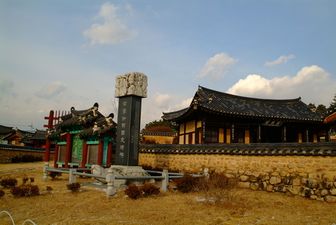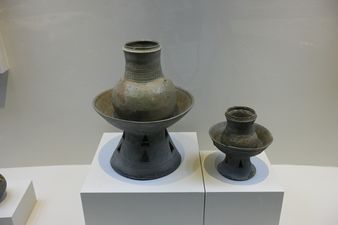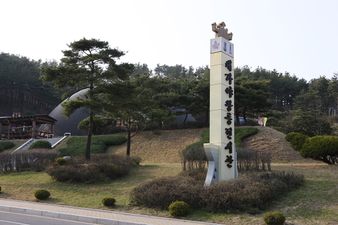"Relations between Korea and Japan in Ancient Times"의 두 판 사이의 차이
(→Relations between Korea and Japan in Ancient Times) |
|||
| 6번째 줄: | 6번째 줄: | ||
[[Gaya Confederacy|Gaya]] is an ancient tribal confederacy that existed in the southern-most part of the Korean peninsula, beginning to form in the 1st century 100 BCE and flourishing until it was conquered and absorbed by the burgeoning Silla Kingdom in the 6th century CE. | [[Gaya Confederacy|Gaya]] is an ancient tribal confederacy that existed in the southern-most part of the Korean peninsula, beginning to form in the 1st century 100 BCE and flourishing until it was conquered and absorbed by the burgeoning Silla Kingdom in the 6th century CE. | ||
<gallery mode=packed heights=150px> | <gallery mode=packed heights=150px> | ||
| − | 파일:1-6.전고령가야 왕릉 Tomb of Goryeong Gaya King.jpg| | + | 파일:1-6.전고령가야 왕릉 Tomb of Goryeong Gaya King.jpg|Tomb of Goryeong Gaya King (Jeungchon-ni, Hamchang-eup, Sangju, Gyeongsangbuk-do) / Courtesy of the Korea Tourism Organization (Kim Ji-ho) |
| − | 파일:2-3.대가야 왕릉 출토물 Exhibition Hall for the royal tomb of Daegaya.jpg| | + | 파일:2-3.대가야 왕릉 출토물 Exhibition Hall for the royal tomb of Daegaya.jpg|Excavated Artifacts from the Royal Tomb of Daegaya (Jisan-ni, Daegaya-eup, Goryeong-gun, Gyeongsangbuk-do) / Courtesy of the Korea Tourism Organization (Park Seong-geun) |
| − | 파일:2-3.대가야 왕릉전시관 Exhibition Hall for the royal tomb of Daegaya.jpg| | + | 파일:2-3.대가야 왕릉전시관 Exhibition Hall for the royal tomb of Daegaya.jpg|Exhibition Hall for the Royal Tomb of Daegaya (Jisan-ni, Daegaya-eup, Goryeong-gun, Gyeongsangbuk-do) / Courtesy of the Korea Tourism Organization (Park Seong-geun) |
</gallery> | </gallery> | ||
2017년 11월 21일 (화) 11:06 판
Relations between Korea and Japan in Ancient Times
Gaya is an ancient tribal confederacy that existed in the southern-most part of the Korean peninsula, beginning to form in the 1st century 100 BCE and flourishing until it was conquered and absorbed by the burgeoning Silla Kingdom in the 6th century CE.
The Gaya Confederacy existed for hundreds of years, developing its own unique culture. It carried out active exchanges with neighboring nations and served as a trade intermediary between Baekje and Japan. In regard to the relationship between Gaya and Japan during the later Gaya period, some Japanese scholars argue that the Yamato Wa invaded the southern part of the Korean peninsula in the 4th century and ruled over Baekje, Silla and Gaya until the mid-6th century, establishing a military base in Gaya called Imna Ilbon-bu (J. Mimana Nihon-fu).
By the 1930s, Japan used this "Imna Ilbon-bu theory" to provide historical grounds for its annexation of Korea in the early 20th century, claiming that Japan ruled the southern part of Korea in ancient times and that Koreans and Japanese have the same ancestry.
The name Imna appears in various records including the epitaph on the Stele of King Gwanggaeto, History of the Three Kingdoms (三國史記, Samguk sagi) and The Chronicles of Japan (日本書紀, Nihon shoki). It refers to either the Gaya Confederacy itself or to Geumgwan Gaya, the ruling city-state of the confederacy. The name Imna Ilbon-bu, however, only appears in the The Chronicles of Japan, not in any Korean or Japanese records.
In recent times both Korean and Japanese scholars have agreed there is little evidence to support the "Imna Ilbon-bu theory." The main documentary evidence comes from the Nihon shoki, which states that the Wa entered and conquered parts of the Korean peninsula in 369. But the book was written in the 8th century, and its records of the pre-5th century period are considered unreliable. An earlier history text, Records of Ancient Matters, does not mention Imna.
It is believed that there was active trade between Gaya, Baekje, and Japan in the 6th century, likely in Ara Gaya, a major Gaya state. Some scholars believe that "Imna Ilbon-bu" may be related to a kind of post to facilitate trade established in Gaya around this time.
References


